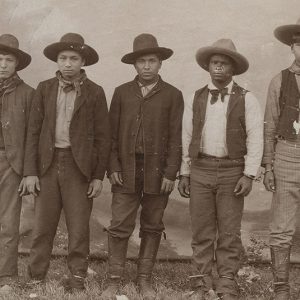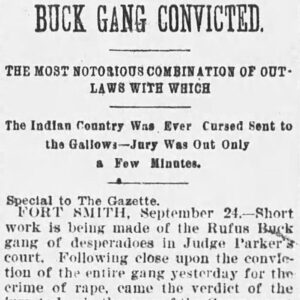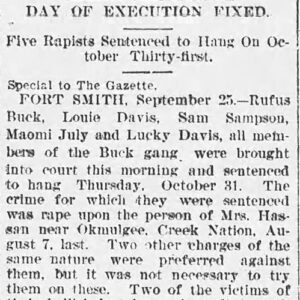calsfoundation@cals.org
Rufus Buck Gang
The Rufus Buck Gang was a group of young men from the Indian Territory who went on a criminal rampage in the summer of 1895; all five were hanged on July 1, 1896, in Fort Smith (Sebastian County), the only people executed for rape from Judge Isaac C. Parker’s court.
Rufus Buck was a Native American of the Yuchi tribe who was angry about the white people who were moving into the Indian Territory. He assembled a gang of petty criminals, all very young, to “make a record that would sweep all of the other gangs of the territory into insignificance.” The others were Lewis Davis, also Yuchi; Sam Sampson and Maomi July, both Creek (Muscogee); and Luckey Davis, who was African American.
Their crime spree began at Okmulgee, Creek Nation, on July 30, 1895, when Buck and the two Davises mortally wounded John Garrett, a deputy marshal. They then headed north, where contemporary newspaper sources say they ran into a man named Ayers and his daughter and gang-raped the woman.
They next came across a timber dealer named Jim Shafey near Okmulgee and, by a four-to-one vote, decided to rob him instead of murdering him. They then attacked a cattleman named Benton Callahan, whose father had expelled Buck from the Wealaka Boarding School, and wounded him while killing his ranch hand, Sam Houston. Seeking to steal fresh horses, they raided the ranch of Gus Chambers on Duck Creek. Chambers fought them off with a shotgun, and though his house was riddled with bullets, they left empty-handed.
Their next victim was Mary Wilson, a widow who was moving her household goods with the help of her son and another man. They robbed the party and raped Wilson. The Okmulgee Phoenix reported that they also killed a farmhand and raped a schoolteacher while in the area.
On August 1, the Buck Gang reached the home of Henry and Rosetta Hassan on Snake Creek, where they gang-raped Rosetta before making Henry dance as they shot at his feet, then forced him to fight another white man until both collapsed from exhaustion. The young criminals then robbed a couple of stores near McDermott.
On August 8, while they were splitting up the loot from the store robberies near Flat Rock Creek, a posse of white marshals and Creek Lighthorsemen attacked and captured all of them except either Lewis or Luckey Davis, who escaped but was caught on August 12.
All five men were convicted on September 23, 1895, in the Federal District Court of Western Arkansas in Fort Smith for the rape of Rosetta Hassan and sentenced to death. Buck and the Davises also were found guilty of murdering Garrett; the Arkansas Gazette wrote that “for downright deviltry and meanness, the Buck Gang can probably lay claim to the blue ribbon over the other notorious combinations of outlaws with which the Indian country has been cursed for years past.”
The gang’s lawyers appealed their convictions to the U.S. Supreme Court, which refused to intervene, then sought clemency from President Grover Cleveland, who declined. On the way from the jail to their sentencing hearing in late April 1896, Buck and the Davises planned to seize their guards’ guns and force them to remove their handcuffs, but “after receiving a blow each quieted down and gave no further trouble.” Parker sentenced them to hang on July 1, 1896.
The five outlaws were baptized into the Catholic Church the day before their execution and spent that night singing hymns with other prisoners in the federal jail at Fort Smith. They also argued about what time they should be hanged the next day, with Luckey Davis seeking a 10:00 a.m. death so his body could make the morning train back to the Indian Territory; the others voted against him, and a marshal set the time for 1:00 p.m. on July 1.
The five young men headed for the gallows at 1:07, with Buck, July, and Luckey Davis wearing large boutonnieres. Only a small group of observers, including the sisters of Luckey Davis and Sampson, were at the execution site. When the trapdoor opened at 1:25, the fall broke the necks of Sam Sampson and Maomi July, and Lewis Davis was dead in three minutes. A newspaper reported that Rufus Buck and Luckey Davis strangled to death. Their bodies were turned over to Birnie’s funeral home for shipment to the Indian Territory.
For additional information:
Akins, Jerry. Hangin’ Times in Fort Smith: A History of Executions in Judge Parker’s Court. Little Rock: Butler Center Books, 2012.
“Buck Gang Convicted.” Arkansas Gazette, September 25, 1895, p. 1.
“Buck Gang Sentenced.” Arkansas Gazette, April 29, 1896, p. 2.
Galonska, Juliet. “Rufus Buck Gang: A Time to Die.” Fort Smith National Historic Site. https://www.nps.gov/fosm/learn/historyculture/rufus-buck-gang-a-time-to-die.htm (accessed February 8, 2023).
Shirley, Glenn. Thirteen Days of Terror: The Rufus Buck Gang in Indian Territory. Stillwater, OK: Barbed Wire Press, 1996.
Wilson, Linda D. “Buck Gang.” Encyclopedia of Oklahoma History and Culture. https://www.okhistory.org/publications/enc/entry.php?entry=BU001 (accessed February 8, 2023).
Mark K. Christ
Central Arkansas Library System
 Law
Law Post-Reconstruction through the Gilded Age, 1875 through 1900
Post-Reconstruction through the Gilded Age, 1875 through 1900 Rufus Buck Gang
Rufus Buck Gang  Rufus Buck Gang Conviction Story
Rufus Buck Gang Conviction Story  Rufus Buck Gang Execution Story
Rufus Buck Gang Execution Story  Rufus Buck Gang Sentencing Story
Rufus Buck Gang Sentencing Story 




Comments
No comments on this entry yet.